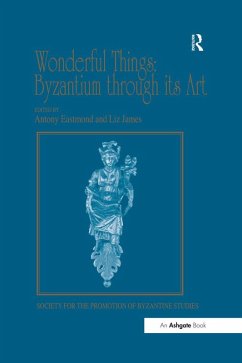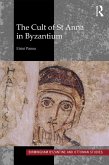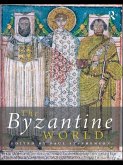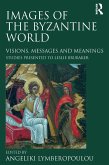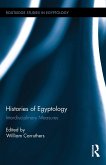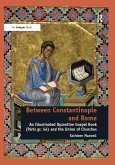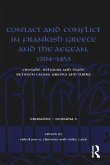Wonderful Things: Byzantium through its Art (eBook, PDF)
Papers from the 42nd Spring Symposium of Byzantine Studies, London, 20-22 March 2009
Redaktion: James, Liz; Eastmond, Antony
41,95 €
41,95 €
inkl. MwSt.
Sofort per Download lieferbar

21 °P sammeln
41,95 €
Als Download kaufen

41,95 €
inkl. MwSt.
Sofort per Download lieferbar

21 °P sammeln
Jetzt verschenken
Alle Infos zum eBook verschenken
41,95 €
inkl. MwSt.
Sofort per Download lieferbar
Alle Infos zum eBook verschenken

21 °P sammeln
Wonderful Things: Byzantium through its Art (eBook, PDF)
Papers from the 42nd Spring Symposium of Byzantine Studies, London, 20-22 March 2009
Redaktion: James, Liz; Eastmond, Antony
- Format: PDF
- Merkliste
- Auf die Merkliste
- Bewerten Bewerten
- Teilen
- Produkt teilen
- Produkterinnerung
- Produkterinnerung

Bitte loggen Sie sich zunächst in Ihr Kundenkonto ein oder registrieren Sie sich bei
bücher.de, um das eBook-Abo tolino select nutzen zu können.
Hier können Sie sich einloggen
Hier können Sie sich einloggen
Sie sind bereits eingeloggt. Klicken Sie auf 2. tolino select Abo, um fortzufahren.

Bitte loggen Sie sich zunächst in Ihr Kundenkonto ein oder registrieren Sie sich bei bücher.de, um das eBook-Abo tolino select nutzen zu können.
The essays collected in this book were delivered at the XLII Spring Symposium of Byzantine Studies, held in London in 2009 to accompany the exhibition Byzantium 330-1453, at the Royal Academy. The exhibition was one of the most ambitious and complex exhibitions ever mounted at the Royal Academy, as well as one of the most popular, and the overall aim of the book is to reflect on the exhibition of Byzantine art, both as an academic and popular exercise, and through the choice and discussion of individual objects.
- Geräte: PC
- mit Kopierschutz
- eBook Hilfe
- Größe: 11.59MB
Andere Kunden interessierten sich auch für
![The Cult of St Anna in Byzantium (eBook, PDF) The Cult of St Anna in Byzantium (eBook, PDF)]() Eirini PanouThe Cult of St Anna in Byzantium (eBook, PDF)43,95 €
Eirini PanouThe Cult of St Anna in Byzantium (eBook, PDF)43,95 €![The Byzantine World (eBook, PDF) The Byzantine World (eBook, PDF)]() The Byzantine World (eBook, PDF)49,95 €
The Byzantine World (eBook, PDF)49,95 €![Images of the Byzantine World (eBook, PDF) Images of the Byzantine World (eBook, PDF)]() Images of the Byzantine World (eBook, PDF)41,95 €
Images of the Byzantine World (eBook, PDF)41,95 €![Histories of Egyptology (eBook, PDF) Histories of Egyptology (eBook, PDF)]() Histories of Egyptology (eBook, PDF)43,95 €
Histories of Egyptology (eBook, PDF)43,95 €![Between Constantinople and Rome (eBook, PDF) Between Constantinople and Rome (eBook, PDF)]() Kathleen MaxwellBetween Constantinople and Rome (eBook, PDF)41,95 €
Kathleen MaxwellBetween Constantinople and Rome (eBook, PDF)41,95 €![Antioch (eBook, PDF) Antioch (eBook, PDF)]() Andrea U. De GiorgiAntioch (eBook, PDF)38,95 €
Andrea U. De GiorgiAntioch (eBook, PDF)38,95 €![Contact and Conflict in Frankish Greece and the Aegean, 1204-1453 (eBook, PDF) Contact and Conflict in Frankish Greece and the Aegean, 1204-1453 (eBook, PDF)]() Contact and Conflict in Frankish Greece and the Aegean, 1204-1453 (eBook, PDF)54,95 €
Contact and Conflict in Frankish Greece and the Aegean, 1204-1453 (eBook, PDF)54,95 €-
-
-
The essays collected in this book were delivered at the XLII Spring Symposium of Byzantine Studies, held in London in 2009 to accompany the exhibition Byzantium 330-1453, at the Royal Academy. The exhibition was one of the most ambitious and complex exhibitions ever mounted at the Royal Academy, as well as one of the most popular, and the overall aim of the book is to reflect on the exhibition of Byzantine art, both as an academic and popular exercise, and through the choice and discussion of individual objects.
Dieser Download kann aus rechtlichen Gründen nur mit Rechnungsadresse in A, B, BG, CY, CZ, D, DK, EW, E, FIN, F, GR, HR, H, IRL, I, LT, L, LR, M, NL, PL, P, R, S, SLO, SK ausgeliefert werden.
Produktdetails
- Produktdetails
- Verlag: Taylor & Francis eBooks
- Seitenzahl: 348
- Erscheinungstermin: 5. Dezember 2016
- Englisch
- ISBN-13: 9781351871105
- Artikelnr.: 49355243
- Verlag: Taylor & Francis eBooks
- Seitenzahl: 348
- Erscheinungstermin: 5. Dezember 2016
- Englisch
- ISBN-13: 9781351871105
- Artikelnr.: 49355243
- Herstellerkennzeichnung Die Herstellerinformationen sind derzeit nicht verfügbar.
Antony Eastmond is Reader in the history of Byzantine art at the Courtauld Institute of Art, University of London. He is author of two books, many articles and has edited two volumes of essays. Liz James is professor of art history at the University of Sussex. She is author of two books, many articles and has edited five volumes of essays.
Contents: Introduction: Byzantium through its art, Liz James and Anthony Eastmond; Part I Exhibiting Byzantium: Learning lessons: from the Mother of God to Byzantium, Maria Vassilki; 'Of what is past, or passing, or to come', Robin Cormack; Two scenes from the prehistory of the Byzantine blockbuster, John Hanson; Exhibiting Byzantium: Edinburgh 1958 and London 2008, Rowena Loverance. Part II Object Lessons: Gospel decoration and its relation to artistic and doctrinal trends of the Middle-Byzantine period: a study with reference to the Marciana book covers, Niki J. Tsironis; The stepmum and the servant: the stepson and the sacred vessel, Cecily Hennessy; The Vienna 'empress' ivory and its companion in Florence: crowned in different glories?, Eileen Rubery; Representing decline and fall: 19th-century responses to the Asclepius-Hygieia and Clementinus ivory diptychs, Helen Rufus Ward; The complexity of the iconography of the bilateral icon with the Virgin Hodegetria and the Man of Sorrows, Kastoria, Teodora Burnand; The last wonderful thing: the icon of the Heavenly Ladder on Mount Sinai. Elena Ene D-Vasilescu; The date of two icons from Sinai, Georgi R. Parpulov; The Nestorian Discos in the light of apocryphal texts and artefacts, Vera Zalesskaya. Part III Byzantium Through its Art: From centre to periphery and beyond: the diffusion of models in late Antique metalware, Anastasia Drandaki; Textiles as text, Anna Muthesius; Some thoughts on Greco-Venetian artistic interactions in the 14th and early-15th centuries, Michele Bacci; Women at tombs: narrative, theatricality, and the contemplative mode, Robert Ousterhout; Show and tell, Leslie Brubaker; The idea of likeness in Byzantium, Anthony Cutler; Mary's parents in homilies before and after James Kokkinobaphos, Eirini Panou; Constantine's city: Constantine the Rhodian and the beauty of Constantinople, Marc D. Lauxtermann. Part IV Exhibiting Byzantium Reviewed: Seeing Byzantium: a personal response, Averil Ca
Contents: Introduction: Byzantium through its art, Liz James and Anthony Eastmond; Part I Exhibiting Byzantium: Learning lessons: from the Mother of God to Byzantium, Maria Vassilki; 'Of what is past, or passing, or to come', Robin Cormack; Two scenes from the prehistory of the Byzantine blockbuster, John Hanson; Exhibiting Byzantium: Edinburgh 1958 and London 2008, Rowena Loverance. Part II Object Lessons: Gospel decoration and its relation to artistic and doctrinal trends of the Middle-Byzantine period: a study with reference to the Marciana book covers, Niki J. Tsironis; The stepmum and the servant: the stepson and the sacred vessel, Cecily Hennessy; The Vienna 'empress' ivory and its companion in Florence: crowned in different glories?, Eileen Rubery; Representing decline and fall: 19th-century responses to the Asclepius-Hygieia and Clementinus ivory diptychs, Helen Rufus Ward; The complexity of the iconography of the bilateral icon with the Virgin Hodegetria and the Man of Sorrows, Kastoria, Teodora Burnand; The last wonderful thing: the icon of the Heavenly Ladder on Mount Sinai. Elena Ene D-Vasilescu; The date of two icons from Sinai, Georgi R. Parpulov; The Nestorian Discos in the light of apocryphal texts and artefacts, Vera Zalesskaya. Part III Byzantium Through its Art: From centre to periphery and beyond: the diffusion of models in late Antique metalware, Anastasia Drandaki; Textiles as text, Anna Muthesius; Some thoughts on Greco-Venetian artistic interactions in the 14th and early-15th centuries, Michele Bacci; Women at tombs: narrative, theatricality, and the contemplative mode, Robert Ousterhout; Show and tell, Leslie Brubaker; The idea of likeness in Byzantium, Anthony Cutler; Mary's parents in homilies before and after James Kokkinobaphos, Eirini Panou; Constantine's city: Constantine the Rhodian and the beauty of Constantinople, Marc D. Lauxtermann. Part IV Exhibiting Byzantium Reviewed: Seeing Byzantium: a personal response, Averil Ca
